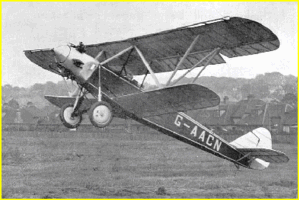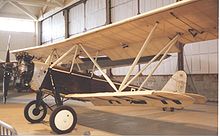Handley Page Gugnunc Video - Picture

|
|
Handley Page Gugnunc
H.P.39 "Gugnunc"

Role: Experimental Utility
Manufacturer: Handley Page
First flight: 1929
Retired: 1934
Number built: 1
The Handley Page H.P.39 was a wooden biplane design of the late 1920s. The aircraft was intended to compete in a competition proposed by the Daniel Guggenheim Fund for the Promotion of Aeronautics - the Guggenheim Safe Aircraft Competition. The original working name for the aircraft was the Guggenheim Competition Biplane. The name Gugnunc was at first unofficial coming from the Pip, Squeak and Wilfred newspaper cartoon (in the Daily Mirror and later in silent films) but it later became official.
Construction and operation

Picture - The HP.39 Gugnunc preserved by the Science Museum at Wroughton airfield, Wiltshire, in July 1992
Only one example of the type was constructed, allotted civil registration G-AACN. It used slots and flaps to achieve the necessary low speed and short takeoff and landing distances for the various safety prizes.
The aircraft competed in the competition in 1929. Most of the competitors failed to enter due to mechanical problems or failure to satisfy the organizers' safety checks. The Gugnunc performed adequately but did not win any prizes.
While there, the HP team noticed that the Curtiss competitors were using an unlicensed version of the Handley Page slot. In the following legal battles, the Curtiss lawyers brought up a postwar judgement that foreign aircraft (and particularly HP aircraft) were prohibited from being imported into the US.
On return to the UK, the aircraft continued experimental flying, and was ultimately purchased by the Air Ministry, given registration K1908, and allocated to the Royal Aircraft Establishment for further testing. The aircraft was struck off in 1934 and presented to the Science Museum. It is currently displayed in the Science Museum annex at Wroughton, Wiltshire.
Specifications (H.P.39)
General characteristics
Crew: 2
Length: 25 ft 9 in (7.85 m)
Wingspan: 40 ft (12.2 m)
Height: ()
Wing area: 293 ft² (27.2 m²)
Airfoil: RAF 28
Empty weight: 1,362 lb (619 kg)
Max takeoff weight: 2,180 lb (989 kg)
Powerplant: 1x— Armstrong Siddeley Mongoose I, 150 hp (112 kW)
Performance
Maximum speed: 112 mph (180 km/h)
Cruise speed: 97 mph (156 km/h)
Stall speed: 33 mph (53 km/h)
Rate of climb: 730 ft/min (222.5 m/min)
Comparable aircraft
Curtiss Tanager
PWS-8
Bibliography
Barnes, C. H. Handley Page Aircraft Since 1907. London: Putnam & Company, Ltd., 1987. ISBN 0-85177-803-8.
Clayton, Donald C. Handley Page, an Aircraft Album. Shepperton, Surrey, UK: Ian Allan Ltd., 1969. ISBN 0-7110-0094-8.
Flight 1930 HANDLEY PAGE TYPE 39 Guggenheim Competition Machine
Handley Page Gugnunc Pictures and Handley Page Gugnunc for Sale.
Living Warbirds: The best warbirds DVD series.
Source: WikiPedia